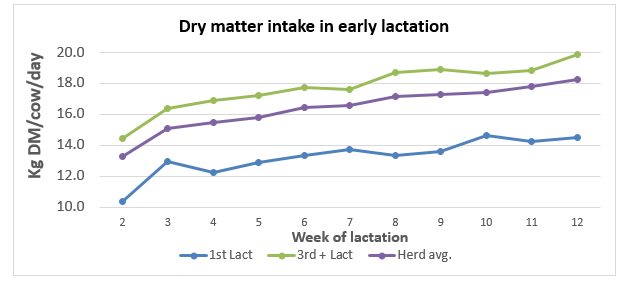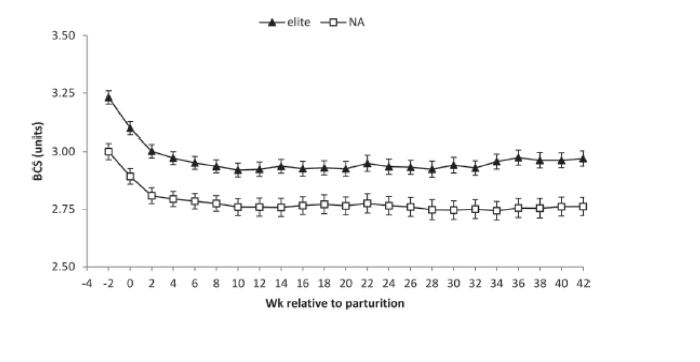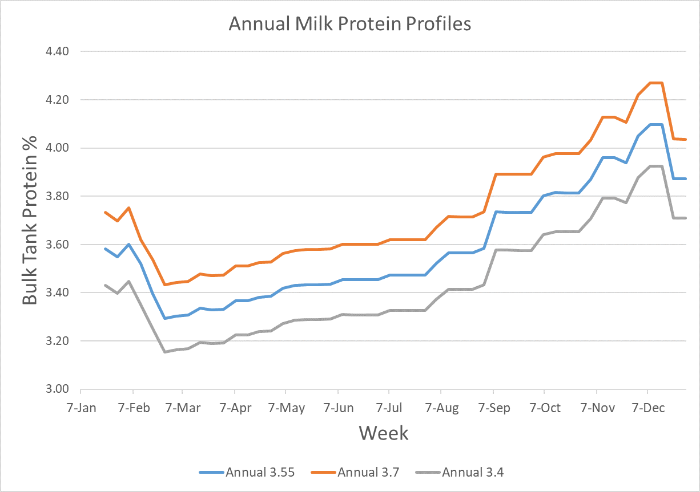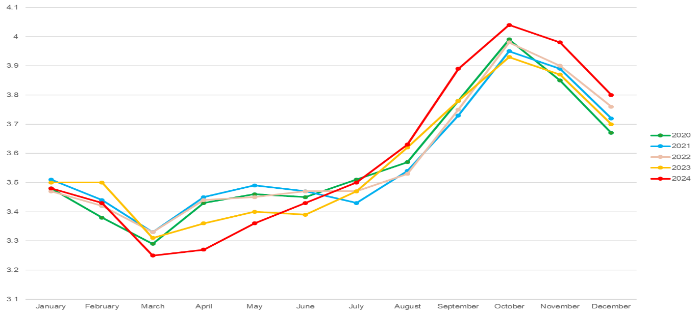6. What level of meal feeding is optimum? What is the expected response?
When we compare the cow’s energy requirement for milk, 0.43 to 0.45 UFL
per kg, to the energy content per kg concentrate as fed which is typically 0.92 to 0.95 UFL, there is, theoretically, sufficient energy in 1 kg concentrate to produce more than 2 kg milk. In a grazing scenario with adequate pasture allowance and quality, a 2:1 milk yield response to additional
concentrate supplementation is impossible. A more standard range of expected response is 0.5 kg to 1.3 kg milk per kg concentrate fed, around a mean of 0.8 to 0.9 kg milk per kg concentrate fed depending on a whole range of considerations.
Substitution rate
A key underlying factor determining milk responses is substitution rate, or the proportion of forage displaced by increasing concentrate supplementation. Factors that affect substitution rate and the milk yield response to concentrate include:
- the proportion of concentrate in the diet
- pasture and silage quality
- quantity of forage offered
- type and quality of supplement offered – alternative forage/concentrate
In early lactation, there is typically minimal substitution observed for the first 3 kg concentration offered. Increasing concentrate allocation beyond this will result in reduced grass DMI and reduced total diet digestibility. However, an increase in total DMI and milk yield are observed. This increased milk production is not linear, and thus the marginal milk response for each additional kg of concentrate is typically lower than at the previous rate of supplementation.
Table 4 illustrates this pattern of response to increasing concentrate across two different levels of pasture quality. There is a diminishing financial return to the farm as the supplement rates increase and the response rate declines. This also means that, by definition, feeding extra concentrate to maximize milk yield will not result in maximum profitability of the farm. In fact the expectation would be that as concentrate feed levels are increased that the profitability would be reduced.
The marginal response to concentrate is best where pasture quality is poorest, i.e. where the diet and cow performance is least favourable. For this reason, it is not valid to evaluate the overall economics of pasture and supplement strategies on a response-to-concentrate basis. It is much more important to focus on increases in pasture utilisation, proportion of grazed grass in the diet, and milk solids efficiency per kg of pasture consumed.
Table 4. Impact of pre-grazing cover and concentrate allocation on grass DMI, total DMI, milk yield and response to concentrate in mid-season (calculations based on Inration V5 (INRA 2018))
A. High quality pasture. Leafy, low NDF content 1400 kg DM/ha pre-grazing cover
| Meal kg as fed – 0.88 DM |
Grass Intake* |
DMI |
Milk kg |
Response per kg as fed |
| 0 |
16.8 |
16.8 |
23.9 |
– |
| 2 |
16.2 |
17.9 |
26.2 |
1.15 |
| 4 |
15.6 |
19.1 |
27.8 |
0.80 |
| 6 |
14.9 |
20.2 |
29.0 |
0.60 |
B. Low quality pasture. Stemmy, high NDF content, >2000 kg DM/ha pre-grazing cover
| Meal kg as fed – 0.88 DM |
Grass Intake |
DMI |
Milk kg |
Response per kg as fed |
| 0 |
14.8 |
14.8 |
17.1 |
– |
| 2 |
14.5 |
16.3 |
19.7 |
1.32 |
| 4 |
14.0 |
17.5 |
21.8 |
1.03 |
| 6 |
13.4 |
18.7 |
23.7 |
0.95 |





